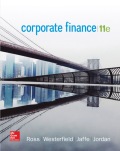
a.
To determine: Choosing between appropriate risk-averse person prefer to invest.
Introduction:
Arbitrage Pricing Theory (APT) is a substitute form of CAPM (
a.
Answer to Problem 8QP
The investor should prefer second market.
Explanation of Solution
In order to prefer the suitable investment it is required to calculate the variance of the portfolios formed by the various stocks from market. The diversification is effective here and it is rational that each investor prefers their own market to invest and buy from the market. We know the variables,
Suppose if we believe that the stocks in portfolio are weighted equally, the weight of each stock is
Suppose if a portfolio is formulated with many stocks with a percentage of
In our scenario,
To implement the above we need to calculate RP and E(RP). By using the supposition on equal weights and substituting the equation for Ri,
We evoke from statistics a property of expected value which is if,
Here “a” is constant and
We use the above equation to find
Now we combine and substituting both the results into a equation for variance,
The last point is since there is many stocks in each market as we require the limit is
Because
Additionally the question says that
Summary of Equations
Now we choose between appropriate risk-averse person prefer to invest,
By substituting
Since the
Therefore investor should prefer the second market
b.
To determine: Choosing between appropriate risk-averse person prefer to invest.
b.
Answer to Problem 8QP
The investor should prefer second market.
Explanation of Solution
Determine the Variance for each Portfolio
Assuming that
Since the
Therefore investor should prefer the second market
c.
To determine: Choosing between appropriate risk-averse person prefer to invest.
c.
Answer to Problem 8QP
The investor should be indifferent between the two markets.
Explanation of Solution
Determine the Variance for each Portfolio
Assuming that
Since the
Therefore investor should be indifferent between the two markets
d.
To determine: The Relationship between the Correlations of Disturbances in two markets.
d.
Explanation of Solution
It is found that the expected return are equal the indifference involves that the variance of portfolio of the two markets are identical. As a result we set the variance formula identical and calculate for the correlation of a market with the other market.
Hence for each set of correlations that have a relationship like in part c, a risk averse investor is entitled as indifferent between the two markets.
Want to see more full solutions like this?
Chapter 12 Solutions
EBK CORPORATE FINANCE
 Essentials Of InvestmentsFinanceISBN:9781260013924Author:Bodie, Zvi, Kane, Alex, MARCUS, Alan J.Publisher:Mcgraw-hill Education,
Essentials Of InvestmentsFinanceISBN:9781260013924Author:Bodie, Zvi, Kane, Alex, MARCUS, Alan J.Publisher:Mcgraw-hill Education,

 Foundations Of FinanceFinanceISBN:9780134897264Author:KEOWN, Arthur J., Martin, John D., PETTY, J. WilliamPublisher:Pearson,
Foundations Of FinanceFinanceISBN:9780134897264Author:KEOWN, Arthur J., Martin, John D., PETTY, J. WilliamPublisher:Pearson, Fundamentals of Financial Management (MindTap Cou...FinanceISBN:9781337395250Author:Eugene F. Brigham, Joel F. HoustonPublisher:Cengage Learning
Fundamentals of Financial Management (MindTap Cou...FinanceISBN:9781337395250Author:Eugene F. Brigham, Joel F. HoustonPublisher:Cengage Learning Corporate Finance (The Mcgraw-hill/Irwin Series i...FinanceISBN:9780077861759Author:Stephen A. Ross Franco Modigliani Professor of Financial Economics Professor, Randolph W Westerfield Robert R. Dockson Deans Chair in Bus. Admin., Jeffrey Jaffe, Bradford D Jordan ProfessorPublisher:McGraw-Hill Education
Corporate Finance (The Mcgraw-hill/Irwin Series i...FinanceISBN:9780077861759Author:Stephen A. Ross Franco Modigliani Professor of Financial Economics Professor, Randolph W Westerfield Robert R. Dockson Deans Chair in Bus. Admin., Jeffrey Jaffe, Bradford D Jordan ProfessorPublisher:McGraw-Hill Education





